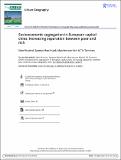Files in this item
Socioeconomic segregation in European capital cities. Increasing separation between poor and rich
Item metadata
| dc.contributor.author | Musterd, Sako | |
| dc.contributor.author | Marcińczak, Szymon | |
| dc.contributor.author | Ham, Maarten van | |
| dc.contributor.author | Tammaru, Tiit | |
| dc.date.accessioned | 2016-09-19T10:30:16Z | |
| dc.date.available | 2016-09-19T10:30:16Z | |
| dc.date.issued | 2017 | |
| dc.identifier | 245970720 | |
| dc.identifier | 9ae3746d-60bd-4de9-9b21-520bb97e0bc8 | |
| dc.identifier | 84987926771 | |
| dc.identifier | 000404652800007 | |
| dc.identifier.citation | Musterd , S , Marcińczak , S , Ham , M V & Tammaru , T 2017 , ' Socioeconomic segregation in European capital cities. Increasing separation between poor and rich ' , Urban Geography , vol. 38 , no. 7 , pp. 1062-1083 . https://doi.org/10.1080/02723638.2016.1228371 | en |
| dc.identifier.issn | 0272-3638 | |
| dc.identifier.other | Bibtex: urn:2259bf37e6117ca25637e78ce6411f56 | |
| dc.identifier.other | ORCID: /0000-0002-2106-0702/work/64697513 | |
| dc.identifier.uri | https://hdl.handle.net/10023/9523 | |
| dc.description | The research leading to this paper has received funding from the Estonian Research Council (Institutional Research Grant IUT no. 2–17 on Spatial Population Mobility and Geographical Changes in Urban Regions); European Research Council under the European Union’s Seventh Framework Programme (FP/2007-2013) /ERC Grant Agreement no. 615159 (ERC Consolidator Grant DEPRIVEDHOODS, Socio-spatial Inequality, Deprived Neighborhoods, and Neighborhood Effects); and from the Marie Curie programme under the European Union’s Seventh Framework Programme (FP/2007-2013) /Career Integration Grant no. PCIG10-GA-2011-303728 (CIG Grant NBHCHOICE, Neighborhood Choice, Neighborhood Sorting, and Neighborhood Effects); and direct funding from the Universities of Amsterdam and Lodz. | en |
| dc.description.abstract | Socioeconomic inequality is on the rise in major European cities, as are concerns over it, since it is seen as a threat to social cohesion and stability. Surprisingly, relatively little is known about the spatial dimensions of rising socioeconomic inequality. This paper builds on a study of socioeconomic segregation in 12 European cities: Amsterdam, Athens, Budapest, London, Madrid, Oslo, Prague, Riga, Stockholm, Tallinn, Vienna, and Vilnius. Data used derive from national censuses and registers for 2001 and 2011. The main conclusion is that socioeconomic segregation has increased. This paper develops a rigorous multifactor approach to understand segregation and links it to four underlying, partially overlapping, structural factors: social inequalities, globalization and economic restructuring, welfare regimes, and housing systems. Taking into account contextual factors resulted in a better understanding of actual segregation levels, while introducing time lags between structural factors and segregation outcomes will likely further improve the theoretical model. | |
| dc.format.extent | 22 | |
| dc.format.extent | 2464455 | |
| dc.language.iso | eng | |
| dc.relation.ispartof | Urban Geography | en |
| dc.subject | Socioeconomic segregation | en |
| dc.subject | Inequality | en |
| dc.subject | Capital cities | en |
| dc.subject | Europe | en |
| dc.subject | Comparative research | en |
| dc.subject | Census data | en |
| dc.subject | G Geography (General) | en |
| dc.subject | H Social Sciences (General) | en |
| dc.subject | NDAS | en |
| dc.subject | SDG 10 - Reduced Inequalities | en |
| dc.subject | SDG 11 - Sustainable Cities and Communities | en |
| dc.subject.lcc | G1 | en |
| dc.subject.lcc | H1 | en |
| dc.title | Socioeconomic segregation in European capital cities. Increasing separation between poor and rich | en |
| dc.type | Journal article | en |
| dc.contributor.sponsor | European Research Council | en |
| dc.contributor.institution | University of St Andrews. Geography & Sustainable Development | en |
| dc.identifier.doi | https://doi.org/10.1080/02723638.2016.1228371 | |
| dc.description.status | Peer reviewed | en |
| dc.identifier.grantnumber | ERC-2013-CoG | en |
This item appears in the following Collection(s)
Items in the St Andrews Research Repository are protected by copyright, with all rights reserved, unless otherwise indicated.

